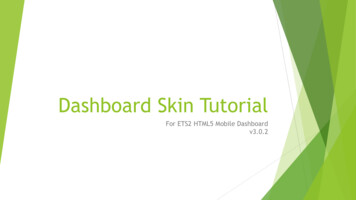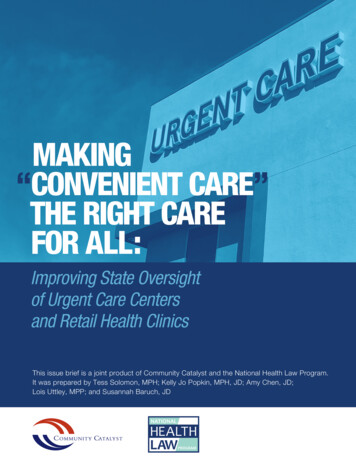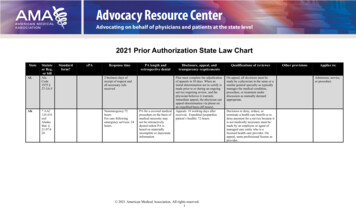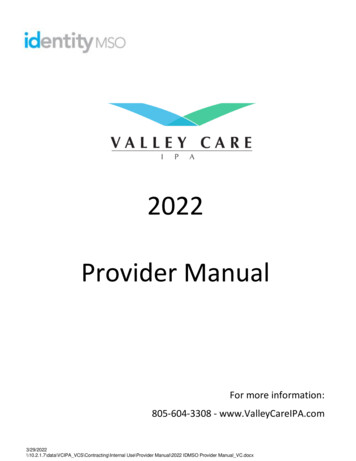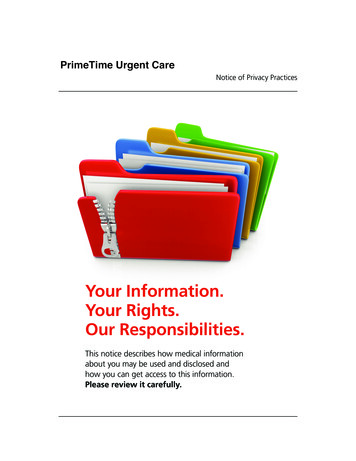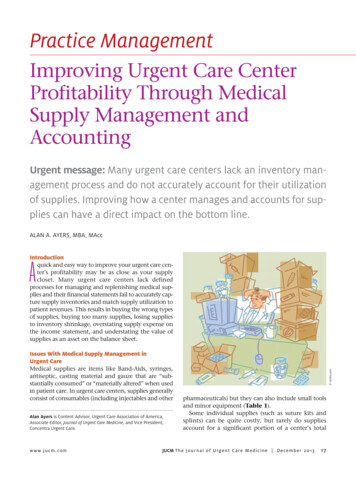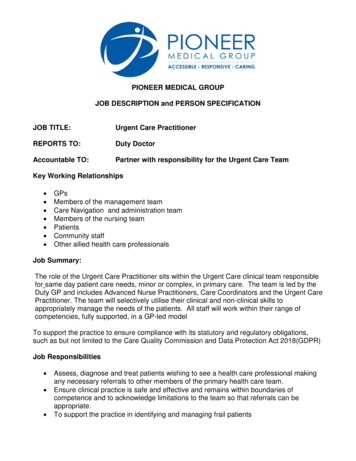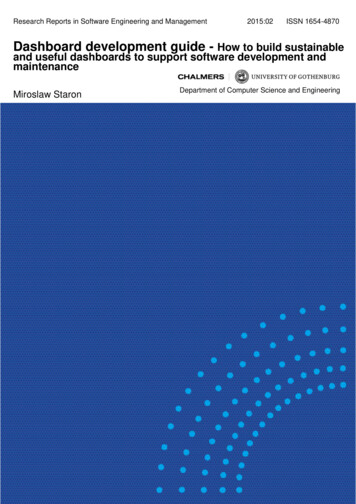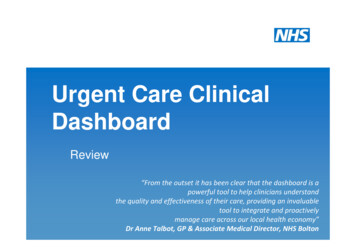
Transcription
Urgent Care ClinicalDashboardReview“From the outset it has been clear that the dashboard is apowerful tool to help clinicians understandthe quality and effectiveness of their care, providing an invaluabletool to integrate and proactivelymanage care across our local health economy”Dr Anne Talbot, GP & Associate Medical Director, NHS Bolton
BackgroundIn March 2008, as part of the Next Stage Review, NHS Bolton was invited to develop a prototype ClinicalDashboard for Primary Care. A Clinical Dashboard is a “toolset developed to provide clinicians with therelevant and timely information they need to inform daily decisions that improve the quality of patientcare”. *The Dashboard that NHS Bolton developed relates to Urgent Care, specifically to combine “real-time” informationfrom their local Acute Trust on A&E attendances, admissions and discharges combined with “real-time”information from Out of Hours and the Walk in Centre to each GP Practice. This information is then displayed in agraphical, user-friendly way to help Practices to more pro-actively manage and co-ordinate patient’s healthcare,especially for the most vulnerable patients and those with long-term conditions. The Dashboard doesn’t containany more information than the Practice already receives from their usual resources e.g. from discharge letters etc,but as these sources can traditionally arrive at different times, the Dashboard instead presents the information in amore timely way and displays all of this information together to present a more complete picture.The Dashboard is used in a number of different ways within the Practice and is used by GPs, Nurses and ActiveCase Managers to name a few.Further reading:Details relating to the original pilot: rvices/clindashRecent (December 2010) Medical Directors bulletin tistics/Bulletins/Medicaldirectorsbulletin/DH 122289*”High Quality Care for All: Our journey so far forall
The Urgent Care Dashboard and QIPPThe programme is part of the Urgent Care Quality, Innovation, Productivity and Prevention (QIPP) workstream andhas Sir John Oldham as the Programme Sponsor. The high level aim is to make the Urgent Care Clinicaldashboard (based on NHS Bolton pilot) available to all PCTs /GP Consortia across England over the next 2 yearsstarting with 10 pioneer sites .ObjectivesTo make the Urgent Care Clinical dashboard available to GP practices across England over the next 2 yearsTo inform the strategy and approach to the wider ‘local’ take-up of the Urgent Care dashboardDevelopment of Local SHA/PCT Cluster/GP Consortia capability to become self-sufficient in supporting localdeployments following Pioneer stageTo support Pioneer sites in obtaining infrastructure, software and skills required to leave the Pioneer sites with anongoing dashboard capability that they are capable of developing furtherTo create a toolkit to support wider take-up of the Urgent Care dashboard including Standards, Logical architecture,data feeds library, detailed design documentation, project management artefacts and updates to metrics repositoryTo engage with key suppliers to agree / produce standards and interfaces
Available supportThis section sets out at a high level the delivery and funding model that is in place for the Urgent Care Dashboard Programme.In essence the centre is providing a small programme management, knowledge management and implementation support role, with onlylimited funding available to do this. The project delivery will be the responsibility of the local NHS/PCT/GP Consortia and there is nocentral funding available to provide local resources, hardware or software. As a result it is expected that each pioneer project will need toconfirm their own business case (where required locally), and be able to provide the necessary resources, and fund the development orprocurement of the technology elements.The central programme management and implementation support is focused on spreading the knowledge and lessons learned from theprevious work at Bolton and from the dashboard work at other trusts to help the local teams organise the best approach to achievesuccess in their environment. A set of standards will also be developed centrally to guide the technical elements of the local projects,and this is necessary due to the number of suppliers who will be involved in the delivery of the projects whether providing data feeds orthe dashboard application itself. The procurement/contracting of suppliers will be at a local NHS level.QIPP/NHS Bolton will be providing: Overall Programme Management Clinical and Informatics expertise on the model deployed across NHS BoltonThe Department of Health Informatics Directorate (DHID) will be providing: A set of standards for use by the implementation projects Initial supplier/market engagement around the standards Initial mobilisation support and implementation consultancy to ensure maximum re-use from the current knowledge base andexperience from the previous pilot programme Authoring and maintaining an implementation toolkit for the Urgent Care dashboardLocal NHS/PCT/GP Consortia: As per section 2.1 in the Expressions of Interest document Any supplier costs for software, hardware, development, etc
Metrics in use at NHS BoltonThe high level diagram below shows the flow of data for the Urgent Care Clinical Dashboard
Metrics in use at NHS BoltonMetricThe numbers of patient events at each of the various local, unscheduled careservices yesterday and for the last seven days, with a drill down to patientdetails, covering:A&E attendances / Admissions / Admissions / Discharges / Out of Hourattendances / Walk In attendancesTotal numbers of patient events at various local, unscheduled care services,for the previous 12 weeksThe numbers of patient events at each of the various local, unscheduled careservices yesterday and for the last seven days, with a drill down to patientdetails, covering:Patients with more than one contact in the last 30 daysA list of patient details for those patients who have attended various local,unscheduled care services, who are on a disease register, and those withmore than one contact in last 30 days:NHS number / Patient name / Contact date / Contact type / Admission Type /Frequency of usage (single and multiple unscheduled care services)A list of patient details for those patients who have attended various local,unscheduled care services, in the last 14 days, including:NHS number / Patient name / Postcode / Date of Birth / Unscheduled careattendances in the last 14 daysFig 1. front screen of the Dashboard showingHigh level metrics.A list of a single patient's details who has attended various local, unscheduledcare services, from the beginning of the database set up, including:Dates of contacts / Dates of discharges / Contact types / Admission types /Discharge types / NHS number / Patient name / Postcode / Date of Birth /Symptoms / Outcomes / Disease registers / Prescribed itemsA list of patient details with the selected type of unscheduled care servicecontact, occurring in the last 30 days, including:Dates of contact / Discharged dates / Contact type / Admission type / NHSNumber / Patient name / Date of birth / Postcode / Symptom / OutcomesA list of patient details for all patients attending unscheduled care on a chosendate, including:Dates of contact / Discharged dates / Contact type / Admission type / NHSNumber / Patient name / Date of birth / Postcode / Symptom / Outcomes /Disease register / Prescribed outcomesFig 2. Example drilldown (not real data).
Dr Anne Talbot, GP & Associate Medical Director, NHS Bolton. Background In March 2008, as part of the Next Stage Review, NHS Bolton was invited to develop a prototype Clinical . starting with 10 pioneer sites . Objectives To make the Urgent Care Clinical dashboard available to GP practices across England over the next 2 years
